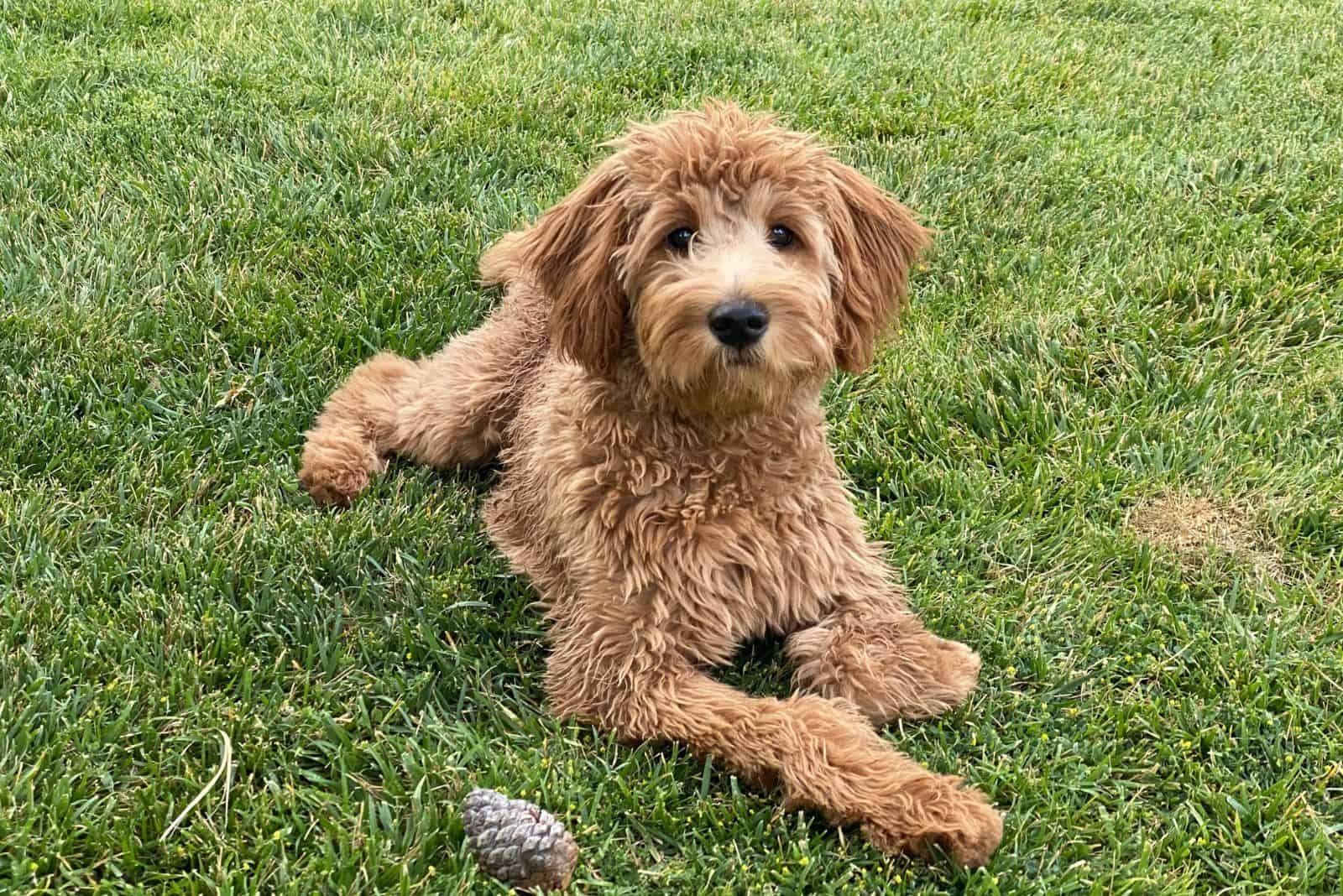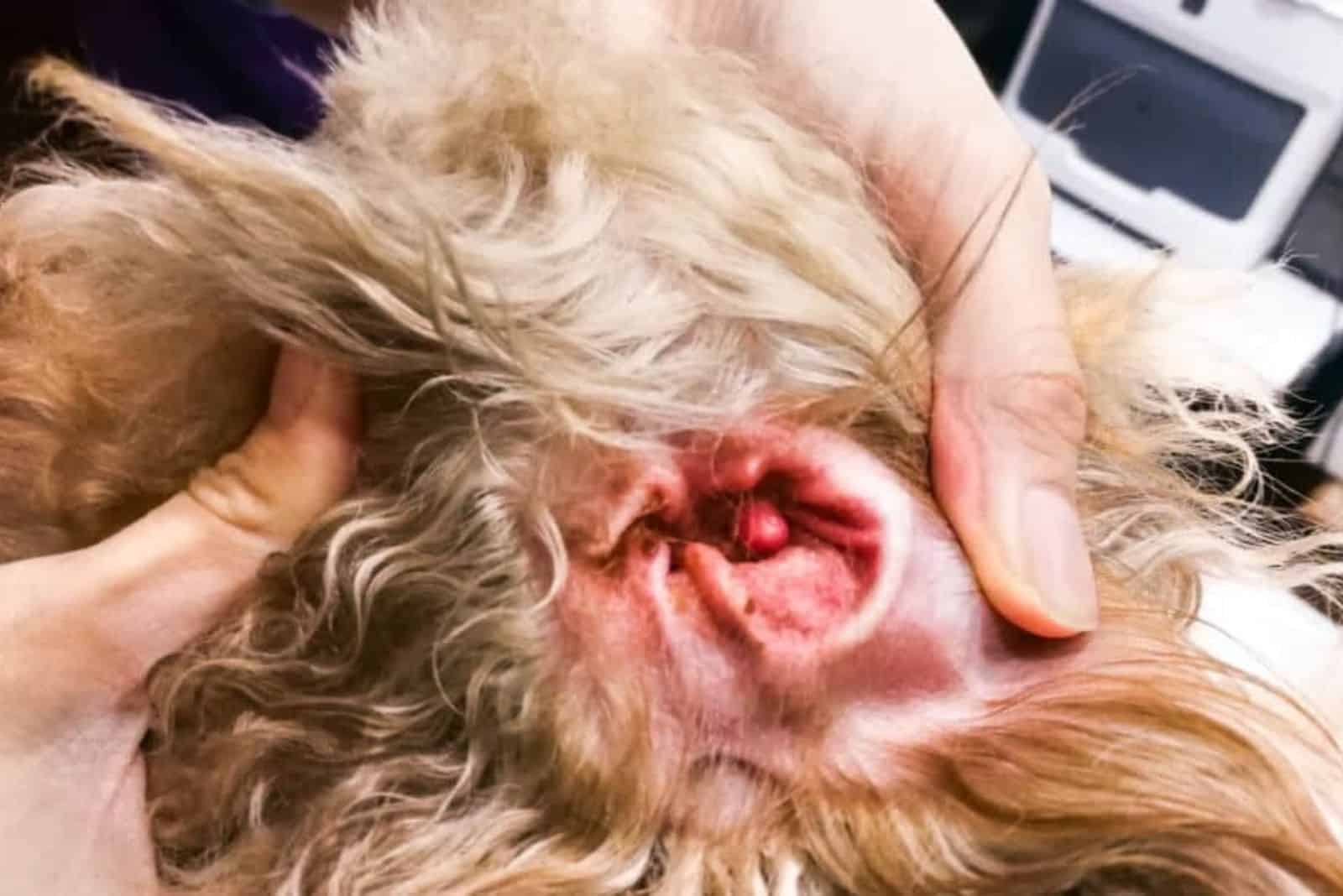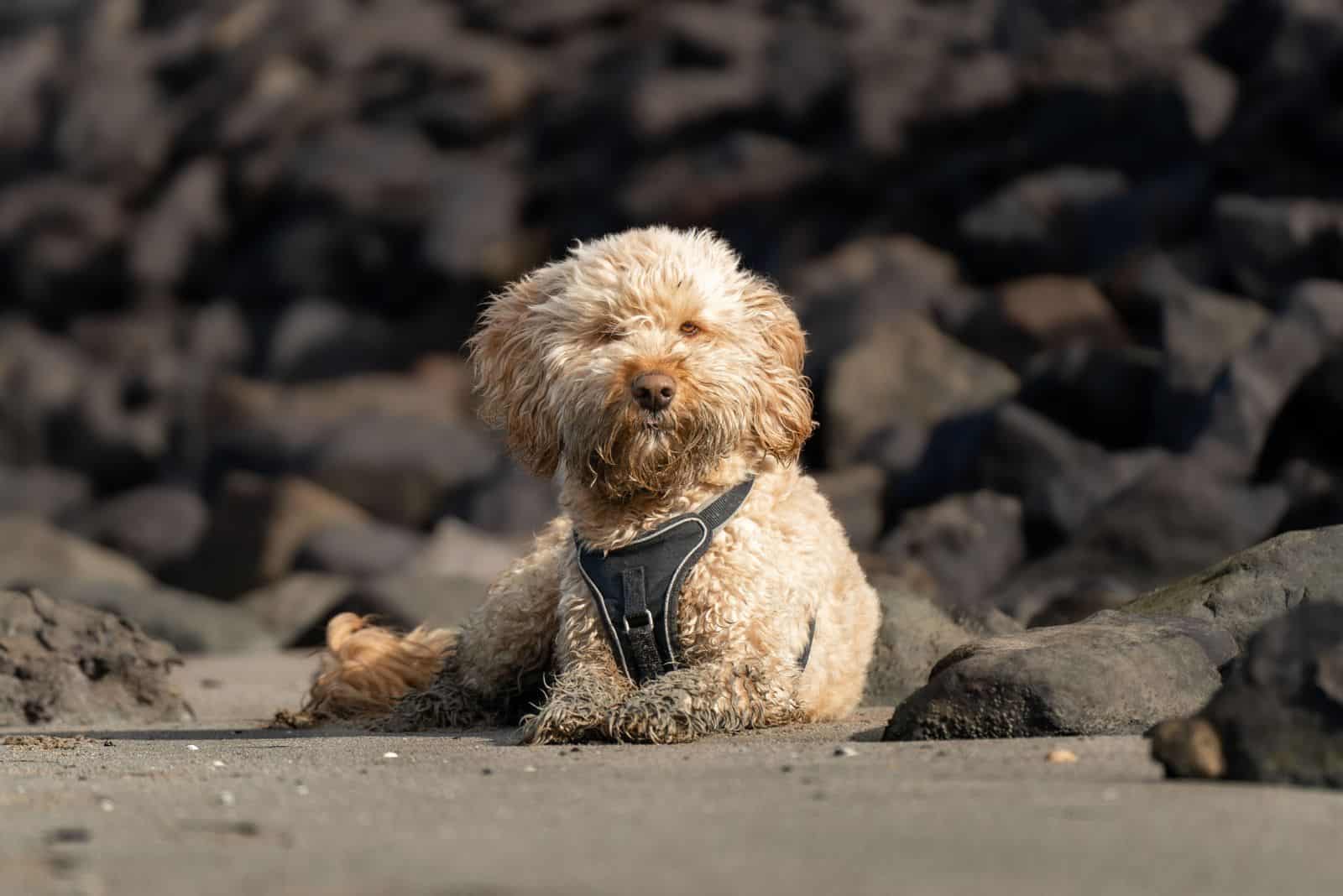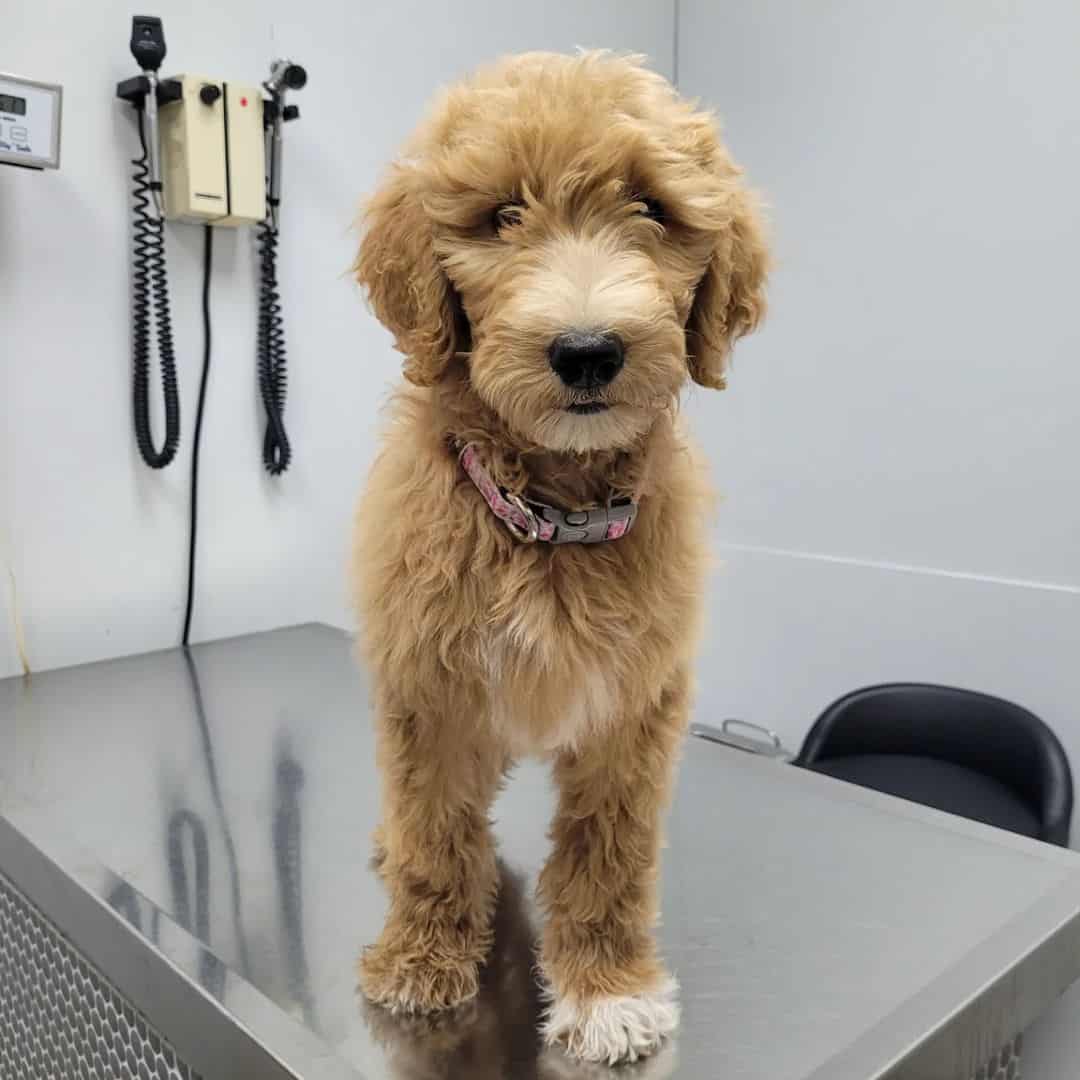Floppy ears have an endearing quality most dog owners appreciate. However, if you like your dog to appear more alert, Goldendoodle ear cropping might be a consideration. Doing this can have some practical benefits, but it is mostly an aesthetic thing.
Being on the fence about putting your Goldendoodle through surgery is normal as their natural ear position is hanging and body alteration surgical procedures can take a toll on both you and your dog.
In this article, we will see what the real benefits of Goldendoodle ear cropping are (if any) and the downsides of such an undertaking. Stick with me as we navigate through the methods, reasons and recovery if you do decide to do it.
A Goldendoodle Owner Might Consider Ear Cropping If…

Since Goldendoodles are not just a crossbreed, but rather a hybrid dog, there is no incentive to crop their ears for conformation events. Although there are clubs in which you can register your mixed breed dog, there is no breeding stock competition that focuses on appearance.
Luckily, if you are feeling like your Goldendoodle cross has the potential to become a champion, you can register it for agility, obedience, and other physical prowess events. Even the American Kennel Club (AKC) has a Partner Program that allows hybrids to compete.
Still, you might prefer the aesthetic of an erect ear to a floppy one and decide that your Goldendoodle’s looks will be improved with an upright ear. In this case, there is no real benefit other than feeling special, and owners often channel their stylistic preferences through their dogs.
Legitimate reasons for ear cropping do exist, but they are so rare it is seldom required. It seems to be a trend to do weird things to dogs, with dog ear piercings being another popular thing that is considered needless and animal cruelty by most authorities.
Still, the the reasons to require ear cropping are most frequently medical problems. Although Goldendoodles are not prone to ear infections, some underlying health issues can make them more susceptible.
In these cases, other methods of preventing infections from recurring are preferred, but ear cropping is considered an option. More extreme reasons for ear cropping include injury, reconstructive surgery, and very infrequently, birth defects.
Do not worry, we will go through each individual reason, the surgical procedure itself and what the recovery period looks like.
1. “Customizing” Your Goldendoodle’s Appearance
To most people it might sound irrational to get a Goldendoodle only to crop its ears as the floppers are a trademark of the crossbreed. However, every owner is different, and an erect ear might look better to them.
Though veterinarians consider ear cropping unnecessary even in purebred dogs, it is an owner’s right to disregard their opinion. Breed standards do not exist for crossbreeds and hybrid dogs, so no organization that allows Goldendoodle registration will have rules for it.
Multigenerational breeding makes sure that the most desirable traits are kept, but it takes time to achieve somewhat predictable results. There are f1, f1b, and other versions of Goldendoodle that have slightly different characteristics.
If you are interested in knowing more about each of them, here is the rest of Goldendoodle multigenerational breeding types:
The only standards imposed on the Poodle and Golden retriever mix are those of the owner. Those of you who are only considering Goldendoodle ear cropping should know that there is a lot of work to keep the ears upright.
Yeah, it is not just cutting a piece of the ear off and calling it a day. The recovery period requires special care and monitoring. We will go through the entire process of the surgery and aftercare later, so stay until the end.
Goldendoodle Ear Cropping Is A Matter Of Finding The Right Veterinarian
Since this mix is not known for its impressive looks with cropped ears, most veterinarians will refuse to do the surgery. That can be for several reasons, like considering it unethical, not having the necessary experience with the procedure, etc.
However, if you do find a vet who is ready to make your Goldendoodle pointier, make sure he is a good one. Not many Goldendoodle owners have their dog go through this procedure, so veterinarians do not have a reference model to shape the ear according to.
You might think this is not a big deal, but it actually is. Nobody wants a vet to improvise ear cropping. There always needs to be some rule as to what is the ideal crop for a breed, regardless of its purity. For Goldendoodles, there is no such “standard”, which makes things more difficult.
2. Recurring Ear Infections

This condition is very common across all dog breeds, which means a Goldendoodle is as likely to have an ear infection as most dogs. Certain dog breeds such as the German shepherd, Labradoodle, Golden Retriever, Cocker Spaniel etc. do have a predisposition to ear infections.
Many believe that the hanging ears are the cause behind ear infections, however that has been scientifically disproved. Otitis externa, commonly known as outer ear infection, occurs in these breeds due to genetic factors such as higher density of apocrine glands, among other factors.
Outer ear infections can happen when moisture, debris, and soil get trapped under the flapper. The germs living in there multiply and look for an opportune moment to enter the bloodstream. Immunocompromised dogs are at a higher risk of otitis externa.
Injury to the ear can also be a quick gateway for the pathogens to enter the inner layers of the skin and the bloodstream. However, these infections are usually easily treated if the symptoms are spotted early.
Clinical signs include head tilting, pawing, scratching the ear, head shaking, redness, scaly skin, hairless patches, colored discharge, and foul odor. Practicing proper ear hygiene after playtime in the mud, water, etc., is crucial for healthy ears.
Keep in mind that no veterinarian will recommend ear cropping due to ear infections. Instead, a full panel of tests is performed to determine the type of infection (bacterial or fungal) and whether an underlying condition has compromised your dog’s immune system.
3. Reconstructive Surgery Due To Injury Or Anatomical Abnormalities
Genetic birth defects that affect the ears, especially of the Goldendoodle and similar crossbreeds are incredibly rare. If, by some chance, your Poodle x Golden retriever mix does have one, Goldendoodle ear cropping is a viable option.
However, if the defect does not affect its hearing and there are no health problems it causes, no veterinarian will advise ear cropping. With ear injury, the story is different. Depending on the extent of trauma to the ear, there might be a reason to remove part of the ear.
Car accidents, fights with other dogs, or even getting the ear caught in a fence can do extensive damage. In those rare cases, a veterinarian can recommend ear cropping, but it might not be as esthetically pleasing as an ear crop meant to look good.
Saving as much healthy tissue is always the priority in such situations. The main goal is to stop the bleeding and preserve nerve endings, not to create a fancy ear lift.
The Origins Of Ear Cropping Through History And Modern Day Misconceptions

Nowadays, a large majority of dog owners are well educated on the matters of dog health and can discern between silly stories and legitimate reasons for ear cropping.
If history taught us anything, it is that being knowledgeable brings much more to the table than accepting conventions rooted in silly beliefs. Ear cropping is one thing that followed this path in history – people inventing reasons for what is essentially animal abuse.
The following statements were considered rational back in the day, and dog owners really believed them to be true. The following historical rationales for ear cropping are completely untrue.
1. Dogs Hear Better With Their Ears Cropped
Although the Goldendoodle was not a thing in the olden days of the Greek and Roman empire, breeds like the Cane Corso, Mastiff, Rottweiler, etc. had their ears cropped for “practical” reasons.
One of those clearly not pragmatic reasons was hearing better. Dogs’ ears are infinitely more sensitive than human ears. They can hear much higher pitched sounds than humans, and a floppy ear does not impair that ability.
With the muscles around the ear, Goldendoodles can simply prick their ears up a bit when alert to focus on the sound. You can test it if you need to see it for yourself. Whisper a trigger word from afar and you will see your floppy-eared friend will instantly turn its head.
2. Cropping Ears Prevents Injury When Fighting Or Hunting
Whether we are talking about the ancient empires or middle ages, dogs were not only man’s best friend but also prolific guards and hunters. The common misconception was that a dog’s fighting ability is reduced if its ears hang.
Getting into a fight and getting that ear caught between the teeth of another dog or animal seemed to be one of the irrational fears people had in times of yore. Similarly, water and hunting dogs had cropped ears due to the “danger” of getting them caught in the bushes.
The floppy ear is a way to protect the ear canal from debris and reduce the amount of water that comes in when a dog jumps into water. Yes, moisture trapped inside a Goldendoodle’s ears can cause problems, but it is not due to them hanging.
Today, it is predominantly done for cosmetic purposes and the American Veterinary Medical Association is clear in its stance against ear cropping and tail docking for aesthetic reasons.
3. Ear Cropping Does Not Hurt When Done Properly
All of the breeds that are “known” for their pricked ears have naturally floppy ears. While some consider that it is similar to ear piercing, it could not be further from the truth.
Human ears do not have as many nerve endings in their earlobes or outer shell of the ear in general as dogs. A dog’s ear is a much more valuable and sensitive tool than for people, so cutting it and posting for weeks definitely hurts.
Just because a dog does not go full drama queen when in pain, it does not mean it feels none. Since the procedure is done between six and twelve weeks of age, the dog is still a puppy.
It is a misconception that puppies do not have a nervous system developed enough to feel the pain of ear cropping.
In fact, the tail docking procedure is somewhat similar to ear cropping in terms of the age it is performed at and surgical complexity, and doing either can cause hyperalgesia once the dog grows into an adult.
Older dogs will have a longer recovery time and will experience more pain after ear cropping, so if you are adamant your Goldendoodle has to have cropped ears, do not wait until it is an adult.
4. Breed Standards Made Me Do It
In the United States, ear cropping and tail docking is not prohibited by law. Even though The American Society for the Prevention of Cruelty to Animals (ASPCA) requested that ear cropping be removed as a requirement for breed standard, the decision was never made.
The American Kennel Club and other US breed-specific dog clubs and associations are still adamant that these body alteration procedures are “part of the breed history and tradition”.
I agree with most animal medical associations and organizations that ear cropping for cosmetic purposes is animal cruelty as it provides no health benefits.
Ear Cropping Surgical Procedure And Recovery

Despite being considered a routine surgery, ear cropping carries certain dangers and potential complications. The choice of veterinarian plays the biggest role in this. Dog owners should always talk to a vet first and ask about their experience in performing this procedure.
Extensive examination of the dog’s physical state and laboratory panels are another deciding factor when it comes to Goldendoodle ear cropping. Testing your dog for allergies is a step you should not skip. Dogs can be sensitive or allergic to certain medications or anesthetics.
Breakdown Of Ear Cropping Surgery
Presuming your DVM did all the necessary checks and test, you will need to provide a picture of the type of ear crop you wish your dog to have. Going blind into this operative manouvre can yield terrible results.
Once on the table, your dog will be anesthetized and the vet will trace out the parts of the ear that need to be removed. After an outline is created, the surgeon will use a clamp to prevent the ear from folding on its own.
The clamp will also make sure that there is minimal bleeding once the ear is cut. For that, the preferred tool is a razor blade with a stiff ridge. Scalpes can be used too, but the razor blade creates a cleaner cut. Surgical scissors are used to create a finer trim at the edges.
Once the desired shape is created, a simple continuous suture technique is used to close the edges. There are more modern techniques that work better for a rounded edge, and the three-bite technique is favored for asymmetrical ear crops.
Once the surgeon is finished with suturing, the ears will be bandaged, and if the crop is long, they will be secured in the proper position to maintain the upright position. For shorter crops, posting is usually not necessary.
Different dog breeds have different types of ear crop available and range from short to long. Goldendoodle ear cropping is a gray area because there are no rules set for it. Not many people decide to perform this procedure on their Goldendoodle.
Post-Operative Care And Recovery
If your Goldendoodle ear cropping surgery requires posting, then you will have to use rolls of gauze to create a post that extends from the ear canal to the highest point of the ear while you wait for the tissue to heal.
Make sure you do not use too much gauze or it might be difficult to take off and manage. Still, the fit has to be snug and tight so that the post does not lose its shape. It takes around fourteen days for the ear to heal properly.
At that point, you will have to visit the vet for suture removal and an assessment of whether the ear crop was successful will be made the week prior. An experienced veterinarian will not have to make corrections after the ear has healed.
To prevent potential infections, the vet will prescribe oral antibiotics and ointments. The ear will have to be cleaned to prevent the formation of scar tissue and infection.
Of course, if you notice your dog is in pain, presence of discharge from the ear, lumps or any other symptoms your veterinarian mentioned as problematic, take your dog to the animal hospital or emergency vet.
A lump can often be a hematoma, so make sure you check out our guide on how to deal with it at home. Of course, you should first contact your vet, but if it is an emergency, knowing what to do can be crucial.
Goldendoodle Ear Cropping FAQ

As I already stated, all veterinary associations and organizations are firmly committed to change the breed standards imposed by kennel clubs that require ear cropping for a dog to participate.
In some states, there have been changes in allowing dogs to participate in conformation events without ear cropping or tail docking. However, the biggest authority in the US dog world, the American Kennel Club, is still adamant it is necessary for preserving traditions and standards.
If there is no medical reason for your Goldendoodle to have cropped ears, then leave them with natural ears. After all, you got this Poodle and Golden retriever mix because it is different to most pure breeds and the ears are a part of it.
Indeed, it is. The United Kingdom, France, German, and most other European countries which agreed and signed the European Convention for the Protection of Pet Animals.
The Fédération Cynologique Internationale has called for changes in breed standards that do not penalize natural ears and tails for breeds that were not allowed participation in conformation events without these body alterations.
Australia and New Zealand, being part of the Commonwealth, have followed the UK’s legislation by proclaiming ear cropping and tail docking illegal. These two procedures are considered mutilation without welfare benefits, so owners and vets who do it can be charged with animal cruelty.
While every veterinarian can have their own price, most ear cropping procedures are between $150 and $600 dollars. The cost does not have to be a sign that the veterinarian is good or bad at performing the procedure.
However, inquire with the veterinarian about Goldendoodle ear cropping, as it is very rare for this mixed dog breed to have cropped ears. Even if you find a veterinarian that is willing to do it, you might pay a premium for it.
Infections and corrective surgery are the two biggest risks invovling Goldendoodle ear cropping. However, there are incredibly rare cases of excessive bleeding during or after the surgical procedure.
Most veterinarians will perform a test that measures the time it takes for a bleed to stop, so they can determine whether ear cropping surgery can be performed at all.
What rarely anyone mentions is the long term behavioral issues that ear cropping surgery can create in dogs. Body language is the main method of communication between dogs, so the inability to move the ears due to chronic pain can greatly affect a dog’s social life
Ending It On A Crop
To put it short and sweet, Goldendoodle ear cropping is not a topic widely discussed on the internet or even at the vet’s office. Every owner of this Poodle and Golden retriever mix got it for the unique appearance, temperament and low shedding potential.
Whether completely shaved or in its full curly gown, the Goldendoodle should have floppy ears. Not only would it look awkward with upright ears, but it would completely defeat the point of having a mixed breed made out of two dogs with hanging flappers.
